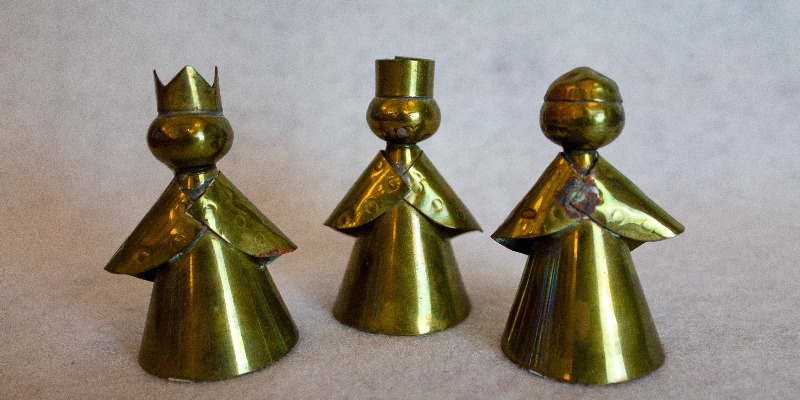The Journey of the Magi - Is it actually any good?

Author: Nick Jowett
Nick Jowett is a former Chair of CAP (Church Action on Poverty) Sheffield and former Vicar and Methodist minister at St Andrew's Psalter Lane Church, Sheffield. |
We’ve all heard T S Eliot’s poem read at Christmas or Epiphany a hundred times, but, apart from the fact that we’re probably rather bored with it, is it any good?
I don’t think it is.
The fact that Eliot, newly converted to Christianity in 1927, wrote it in forty-five minutes over half a bottle of gin does not bode well. He borrowed the first five lines from a sermon by Lancelot Andrewes, so he was clearly not feeling too inspired in himself, even though he had the grace to put quotation marks round those lines.
And who are these magi? Their imagined pilgrimage is woven out of the story in the second chapter of Matthew’s Gospel which itself has no historical foundation and was created by the evangelist to introduce a theme of Christ as a revelation to the non-Jewish world. So the magi of Eliot are doubly imagined (or triply, if you add in Lancelot Andrewes!) They are a part of a productive Christian industry, begun by Matthew and Luke, of creating and then embroidering imagined stories of the specialness of Jesus’ birth, sadly ignoring a much profounder statement of faith, that the incarnation was about God being born as an insignificant carpenter’s son from Nazareth, with no fanfares or VIP visitors.
So what voice does Eliot give his narrating magus? It’s the voice of an elderly upper-class Englishman forced for some reason to travel second class on British Rail and stay at Wetherspoons: it’s one long complaint about the physical discomforts, the poor service and bad behaviour of the lower class servants, the unfriendly foreigners and the high prices (as if such elite persons couldn’t pay them!); and pure nostalgia for life back at the club where lovely female servants (girls!) brought drinks at their command. It’s one long moan, and although they’re pictured as under some strong compulsion, the reader is going to find it hard to sympathise.
When they reach the temperate valley, Eliot decides to chuck in some vaguely Christian symbols: the running stream (baptism?), the three trees (crucifixion), the old white horse (apocalypse?), the vines and the wine skins (miracles or parables), pieces of silver (Judas) and dice (soldiers at the crucifixion); but this sudden springtime picture is a scattergun evocation of a ‘new era’, and it no doubt leaves even most Christian readers slightly puzzled.
Even more puzzling is the total absence of any picture of the Christ-child and his parents or of the feelings evoked at the moment of arrival and seeing the baby Jesus. Perhaps T S Eliot was worried about falling into something merely picturesque or sentimental? While I am quite sure that Matthew invented the guiding star, the role of Herod, the gifts of gold, frankincense and myrrh, and the overwhelming joy of the magi, Eliot has chosen to edit out most of the significant motifs of the Bible story. Once again, Eliot gives us the reaction of a down-beat, stiff-upper-lip Englishman: when the magi at last get to the right place, it’s just ‘satisfactory’!
In the last section Eliot loses whatever sense there might have been of Persian astrologers and puts into the mouth of his magus reflections that no traveller at that moment in time or even thirty years later could possibly have entertained. The idea that Jesus’ birth is a cosmic watershed and that previous faiths are thereby superseded, even abrogated, is a Christian notion lying far ahead at the moment of this imagined encounter: our magus’s gloom about returning to a people whose faith is suddenly seen as invalid – dead – is pretty unconvincing.
There is also a nasty whiff of supersessionism here: of course it’s a pagan faith that is being superseded in the poem, but Christianity for the most part no longer regards other faiths as dead and valueless, so that the black and white contrast pictured here no longer chimes well with that. Sadly, Christendom has for most of its centuries regarded Judaism itself as superseded, and we can wonder whether the anti-Semitic Eliot doesn’t peep through here.
Christmas and Epiphany are joyful Christian feasts, and even people like me who don’t believe that Matthew and Luke thought they were doing history when they told the stories of Jesus’ birth can enjoy their Bethlehem tales of ‘heaven in ordinary’. But it may well say something about the church’s welcome to the convert T S Eliot in 1927 that it has gone on lionising a poem which is carelessly written and ill-thought-through, which is actually untrue to the gospel narrative and which somehow extraordinarily inhabits an atmosphere of upper-class depression. I think many Christian readers must be quite puzzled and troubled by the miserable down-beat ending.
Author/copyright permissions
Reproduced with permission of the author.
Photo Credit: Lee Young on Unsplash |